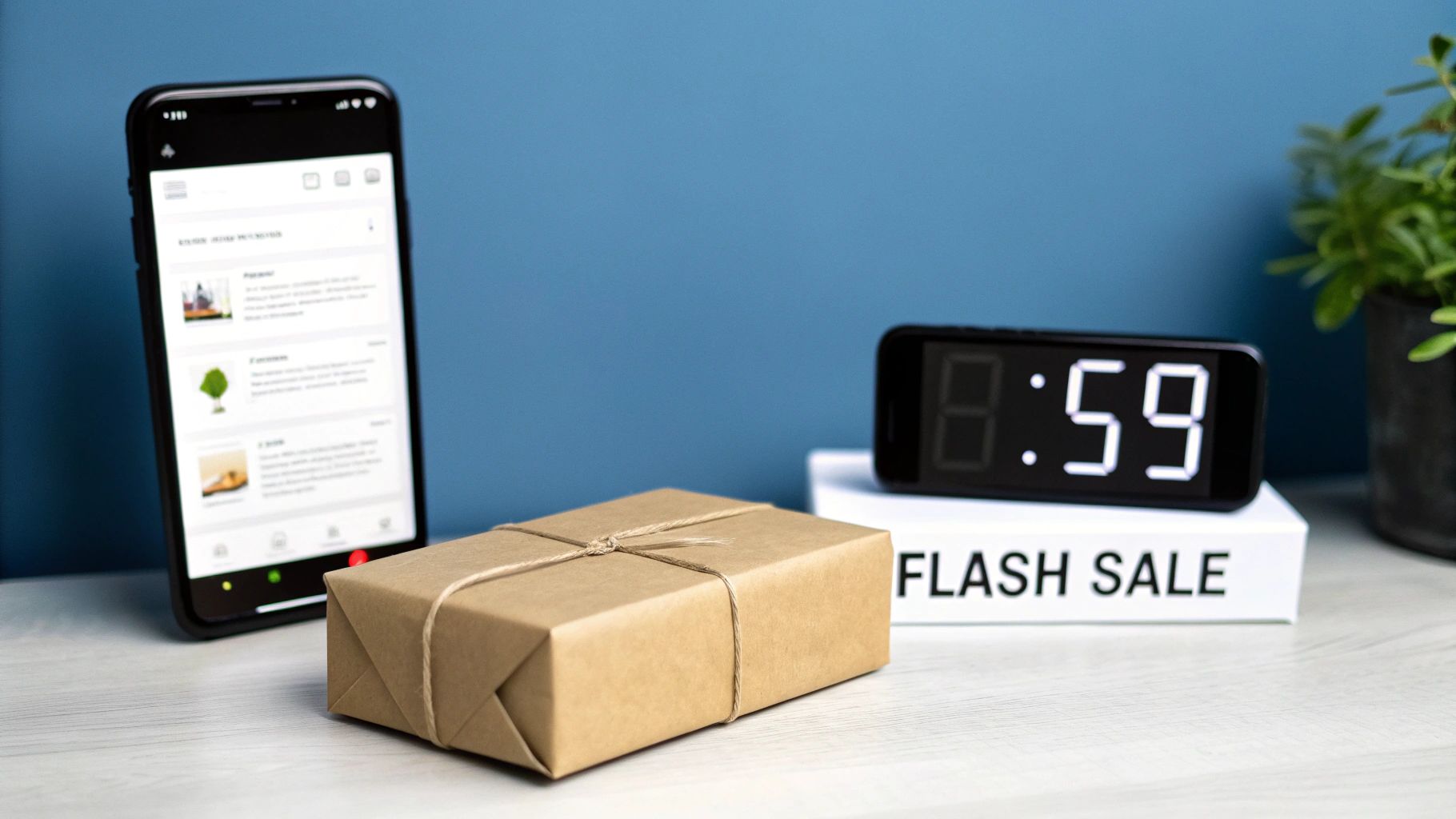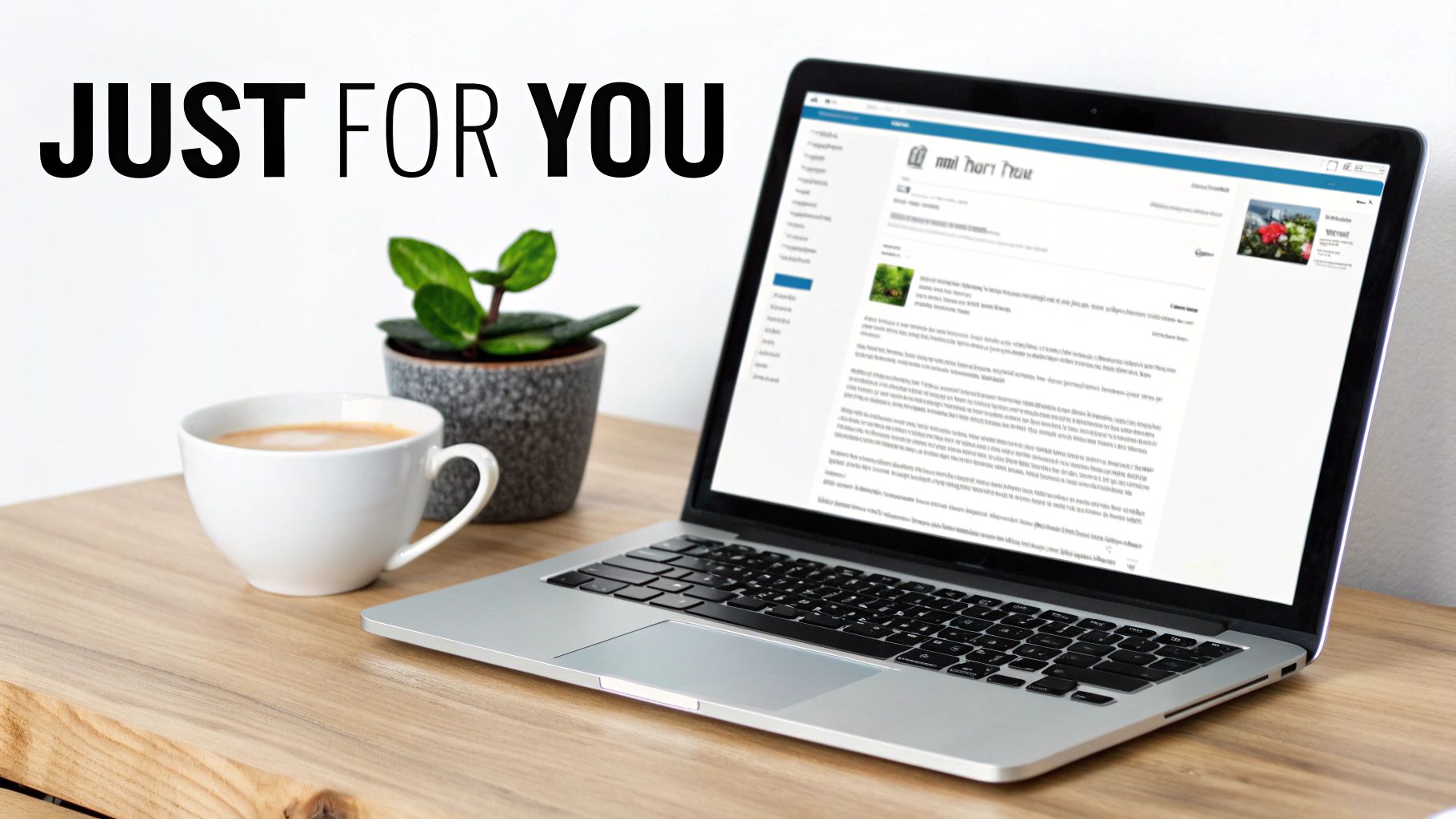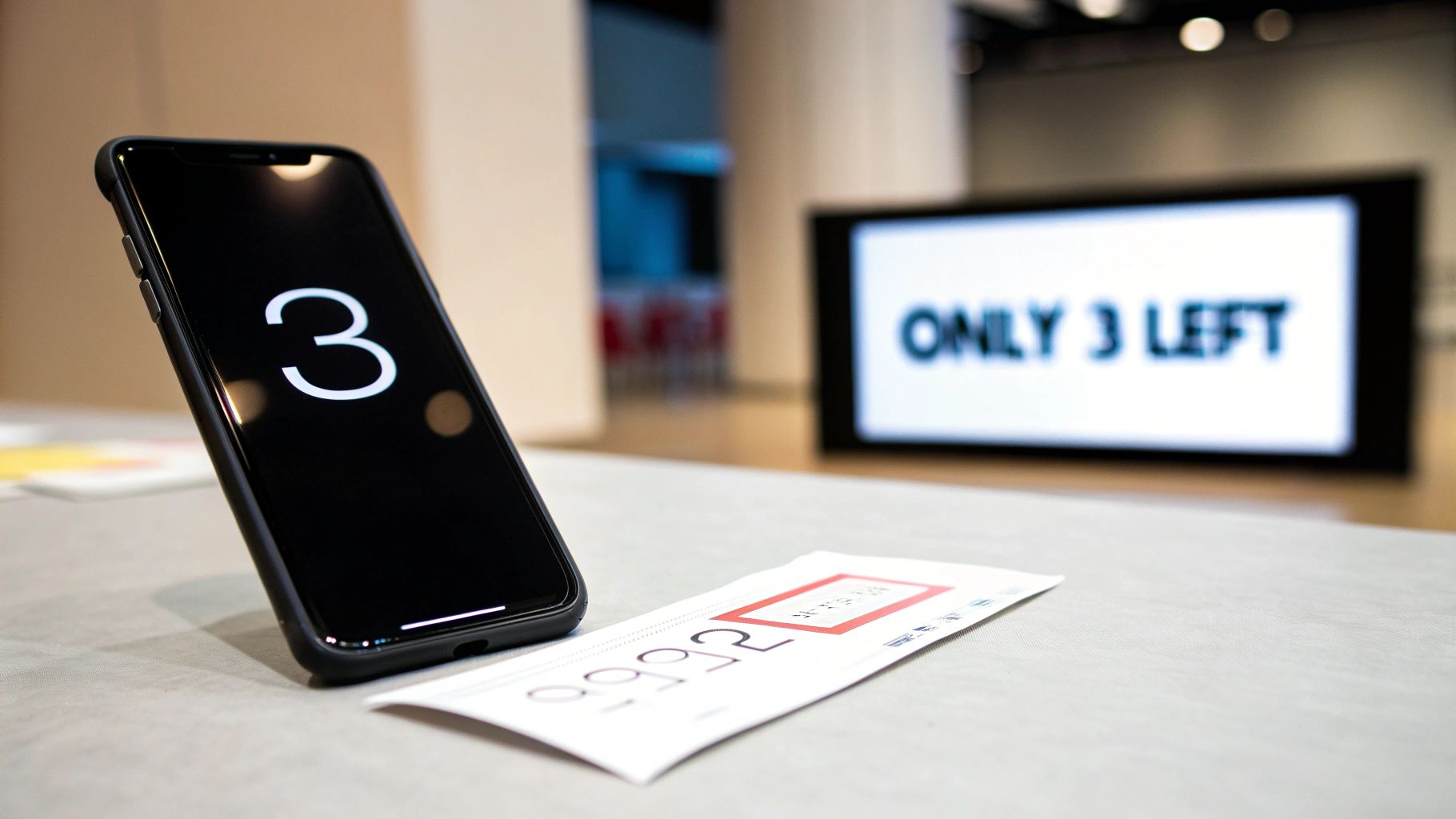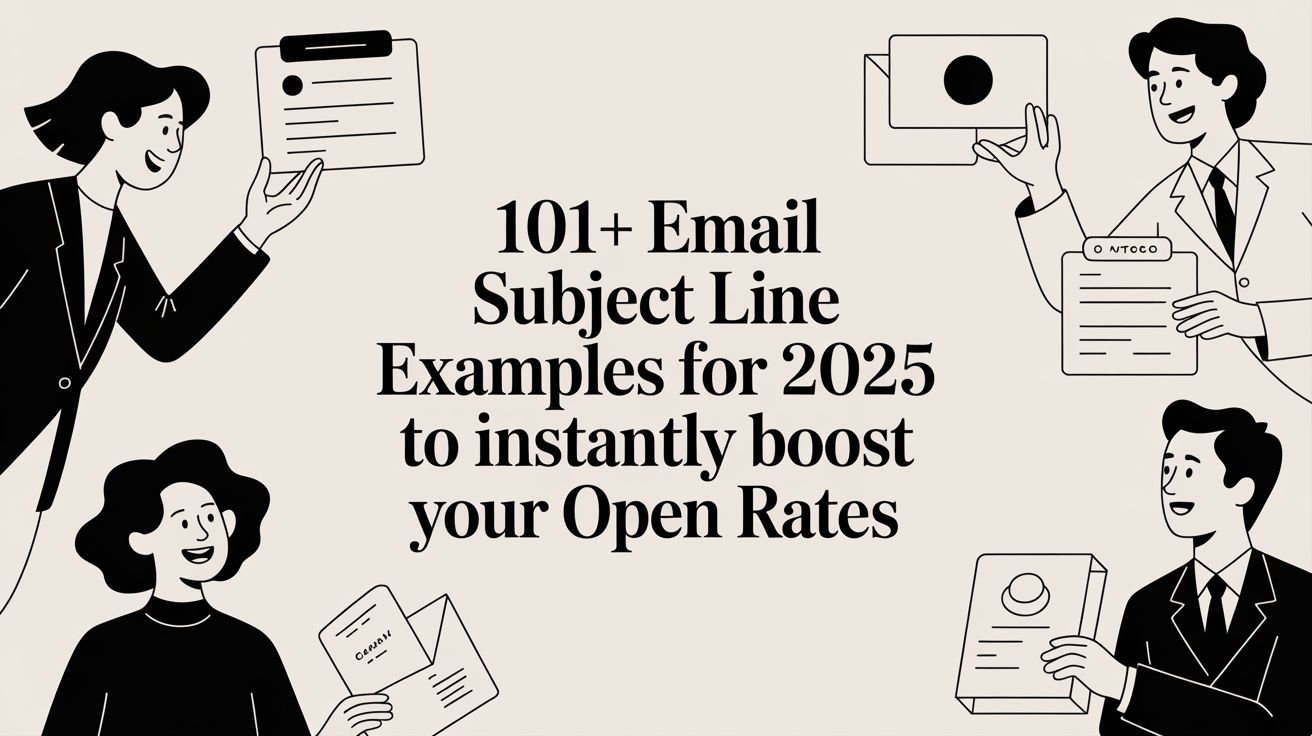In a crowded inbox, your email subject line is the single most critical factor determining whether your message gets read or ignored. It's the gatekeeper to your entire campaign—a one-sentence pitch that can make or break your open rates, engagement, and ultimately, your sales. A weak subject line renders even the best email invisible. A compelling one, however, is a strategic tool that can transform your email marketing performance.
This article is your definitive, actionable playbook for mastering this crucial skill. We’re moving beyond generic advice to provide a comprehensive collection of over 100 high-performing email subject line examples, meticulously organized into 10 categories tailored to specific marketing goals. Whether you want to drive sales, re-engage dormant subscribers, or build curiosity, we’ve covered every angle.
But we won't just show you what works—we’ll explain why. For each category, we’ll provide a step-by-step strategic breakdown:
- The Strategy: A concise analysis of the psychology behind why it captures attention and compels a click.
- The Examples: Real-world subject lines that you can adapt for your own campaigns.
- Actionable Takeaways: Simple, step-by-step advice you can apply immediately to craft better subject lines today.
This isn't just a list; it’s a strategic resource built to help you write subject lines that get results. Let's get started.
1. Promotional/Sales Email Subject Lines
Promotional subject lines are the workhorses of any sales-focused email strategy. Their primary goal is to drive immediate action—like a purchase—by creating a compelling sense of value or urgency. These are among the most common email subject line examples because they tap directly into a subscriber's desire for a good deal. They work by clearly communicating a time-sensitive benefit, motivating readers to click before they miss out.

The Strategy
The power of a promotional subject line lies in its clarity and use of psychological triggers. By using numbers, symbols, and urgent language, they stand out in a crowded inbox and make the value proposition instantly understandable. Brands like Groupon and ASOS have perfected this approach, making it a cornerstone of their email marketing. The most successful promotional subject lines combine a specific, quantifiable offer (e.g., 50% OFF) with a clear deadline (e.g., 24 Hours Only!). This pairing creates a powerful psychological nudge, activating the fear of missing out (FOMO).
Examples
50% OFF - 24 Hours Only!(Combines a strong discount with immediate urgency.)Flash Sale: Save $100 on Premium Plans(Signals a short-term, high-value event and makes the benefit tangible.)Exclusive: Free Shipping This Weekend(Makes the subscriber feel special while removing a common purchase barrier.)
Actionable Takeaways: How to Apply This
- Step 1: Be Specific with Numbers. Use percentages (40% OFF) or concrete dollar amounts ($25 off) instead of vague terms like "Big Savings." Numbers are more persuasive and easier to process.
- Step 2: Create Scarcity. Employ time-based urgency with phrases like "Ends Tonight," "Last Chance," or "24-Hour Deal." You can also use stock-based scarcity, such as "Limited Stock."
- Step 3: A/B Test Your Offers. Don't assume what will work best. Test different discount levels (20% vs. 25%) or framing ("$10 Off" vs. "Free Shipping") to see what resonates most with your audience.
2. Newsletter/Content Email Subject Lines
Newsletter subject lines are designed for long-term engagement rather than immediate sales. Their primary goal is to build a relationship and establish a consistent reading habit by delivering value, education, or entertainment. Unlike promotional emails, these email subject line examples focus on curiosity and reliability, encouraging opens by promising insightful content and positioning you as a trusted source of information.
The Strategy
The strength of a newsletter subject line lies in its consistency and clarity. By establishing a recognizable format, brands like Morning Brew and The Skimm train their audience to spot their emails instantly. The key is to create a template that is familiar yet flexible enough to hint at the unique value inside each issue. Successful newsletter subject lines act as a reliable "brand wrapper" for your content. Using consistent elements like brackets [Newsletter Name] or a recurring day of the week creates a powerful recognition trigger.
Examples
The Monday Briefing: What You Need to Know(Establishes a routine and promises curated, essential information.)Your Weekly Digest: Top 5 Industry Trends(Signals a scannable summary with a specific, numbered list that is easy to consume.)[The Growth Hub] - How We Grew Our Blog to 1M Readers(Uses a branded prefix for recognition and highlights a compelling, results-oriented case study.)
Actionable Takeaways: How to Apply This
- Step 1: Establish a Consistent Format. Use brackets, a consistent opening phrase (e.g., "This Week In..."), or an issue number to make your newsletter instantly recognizable. This is one of the core best practices for email subject lines for building an audience.
- Step 2: Highlight the "Hero" Content. Tease the most valuable or intriguing article from your newsletter directly in the subject line to maximize curiosity and drive opens.
- Step 3: Test Questions vs. Statements. A/B test a question-based subject line (e.g., "What's the future of AI in marketing?") against a statement (e.g., "The future of AI in marketing is here") to see which style better engages your subscribers.
3. Re-engagement/Win-back Email Subject Lines
Re-engagement subject lines are designed to reconnect with inactive subscribers. Their goal is to reignite interest by reminding customers why they signed up and offering a clear benefit to return. These subject lines tap into curiosity, exclusivity, and nostalgia to persuade dormant contacts to open your email and give your brand another look.
The Strategy
The best win-back subject lines directly acknowledge the subscriber's inactivity and immediately follow up with a tangible incentive. By calling out that someone hasn't engaged lately, you make the message feel personal and timely. Including a specific offer—like a discount or a peek at new features—provides a compelling reason to click. Brands like Spotify and Dropbox use this tactic to reactivate dormant users and improve long-term retention. The key is blending honesty with a genuine value proposition.
Examples
- “We miss you! Here’s 20% off to come back” (Opens with emotion and pairs it with a concrete offer to lower the barrier for return.)
- “Is this goodbye? Your exclusive offer expires soon” (Combines urgency with exclusivity to motivate immediate action.)
- “Some things have changed since you’ve been gone…” (Appeals to curiosity by teasing updates or improvements, inviting subscribers to rediscover your brand.)
Actionable Takeaways: How to Apply This
- Step 1: Segment Your Inactive Users. Create a segment of subscribers who haven't opened or clicked an email in a specific timeframe (e.g., 90 days) to target your campaign precisely.
- Step 2: Personalize the Subject Line. If possible, use the subscriber's name or reference a past purchase to make the message feel more relevant.
- Step 3: Offer a Genuine Incentive. Provide a real reason for them to come back, whether it's a discount, a free trial, or access to an exclusive new feature.
- Step 4: A/B Test Your Tone. Test a friendly, emotional tone ("We miss you!") against a more direct, benefit-driven one ("Don't miss out on what's new") to see what works best.
4. Transactional/Confirmation Email Subject Lines
Transactional subject lines are for automated messages like order confirmations, password resets, and shipping updates. Their goal is clear, immediate communication, not direct marketing. These email subject line examples build trust by delivering critical information exactly when your customer expects it. For more in-depth best practices, learn more about Transactional/Confirmation Email Subject Lines on emailgum.com.
The Strategy
The best transactional subject lines excel through clarity and consistency. They typically include an action descriptor (like "Order Confirmation") and a unique identifier (like an order number). This format helps your audience instantly recognize the email’s purpose and find it later. Top brands like Amazon and PayPal prioritize this pattern to reduce customer support tickets and boost confidence. The most effective transactional subject lines are direct, informative, and predictable.
Examples
Order Confirmation #12345(The reference number lets customers immediately identify the purchase and find the email later.)Your password reset link is here(A clear call-to-action that signals an urgent security step.)Your package has shipped! Tracking #ABC123(Including "Tracking" plus the number sets clear delivery expectations.)Your receipt for your purchase on Oct 15(The date stamp clarifies the transaction timeline for easy record-keeping.)
Actionable Takeaways: How to Apply This
- Step 1: Lead with the Purpose. Start the subject line with the email's primary function (e.g., "Order Confirmation," "Password Reset").
- Step 2: Include a Key Identifier. Always add an order number, tracking code, or case number to make the email easy to reference.
- Step 3: Keep It Concise. Aim for under 50 characters so the full subject line displays clearly on mobile devices, where these emails are often opened.
- Step 4: Maintain a Consistent Format. Use the same "Action – Identifier" pattern across all your transactional emails to create a reliable experience for your customers.
5. Question-Based/Curiosity-Gap Email Subject Lines
Question-based subject lines are designed to spark curiosity. By posing an intriguing question, they leverage a psychological principle called the "curiosity gap"—the desire to fill a gap in one's knowledge. These email subject line examples encourage high open rates by making a promise of an answer, as long as that promise is closely tied to a pain point or interest of the reader.
The Strategy
This approach works by activating the brain’s natural need for closure. When subscribers see a relevant question, they feel an unconscious pull to find the answer inside the email. For this to be effective, the question must feel specific and genuine rather than vague or like clickbait. A well-crafted question-based subject line uses familiar scenarios or intriguing hints to make the curiosity gap both compelling and credible.
Examples
What's the #1 mistake you're making with [Topic]?(It zeroes in on a pain point and promises a single, actionable insight.)Are you paying too much for [Service]?(This taps into a common fear and suggests the email holds the key to saving money.)Can we make your job 10x easier?(The question feels personal and generous, driving curiosity about how simple the solution might be.)
Actionable Takeaways: How to Apply This
- Step 1: Identify a Key Pain Point or Goal. Brainstorm the biggest challenges or aspirations your audience has.
- Step 2: Frame It as a Question. Turn that pain point into a direct question. For example, "Struggling with low open rates?" becomes "Why are your open rates so low?"
- Step 3: Ensure Your Email Delivers the Answer. The content of your email must provide a clear, satisfying answer to the question posed in the subject line to maintain trust.
- Step 4: A/B Test Against a Statement. Compare your question-based subject line with a statement-based alternative (e.g., "The reason your open rates are low") to see which performs better.
6. Personalized/Dynamic Email Subject Lines
Personalized subject lines use recipient data—like their name, location, or past behavior—to create a one-to-one feel. This strategy transforms a mass email into a message that feels individually crafted, instantly increasing its relevance. These dynamic email subject line examples cut through inbox noise by addressing the subscriber directly, fostering a stronger connection and significantly boosting open rates.

The Strategy
The power of personalization comes from its ability to validate the subscriber's relationship with your brand. By using their name or referencing a recent action, you confirm you're not just sending a generic blast. Platforms like Klaviyo and HubSpot make this tactic accessible, allowing marketers to automate hyper-relevant messaging. The best personalized subject lines go beyond just using a first name. They combine personal data with a clear value proposition, like referencing a recently viewed product, to create a message that is both personal and highly relevant. For a deeper dive into making a strong first impression, explore best practices for crafting an effective introductory email with a personalized subject line.
Examples
[FirstName], we saved your cart for you(Combines the subscriber's name with a helpful, behavior-triggered action for a relevant reminder.)Still looking for a great deal in [City]?(Uses location data to create a highly specific and compelling reason to open.)Sarah, here are some recommendations based on your recent purchase(Using a name grabs attention, while "recommendations" promises curated, personal value.)
Actionable Takeaways: How to Apply This
- Step 1: Start with the First Name. The easiest way to begin is by adding a
[FirstName]merge tag to your subject lines. - Step 2: Go Beyond the Name. As you get more advanced, use location, past purchase categories, or browsing history to create truly dynamic subject lines. The more specific the data, the more relevant the message.
- Step 3: Set Up Fallbacks. Always configure a default value (e.g., "A special offer for you") for cases where you don't have personalization data, like a subscriber's first name, to avoid sending an awkward, broken subject line. Learn more about personalization in email marketing.
7. FOMO (Fear of Missing Out) Email Subject Lines
FOMO subject lines leverage a powerful psychological trigger: the anxiety of missing out on a rewarding experience. Their goal is to compel subscribers to act immediately by highlighting scarcity, exclusivity, or a rapidly closing window of opportunity. These email subject line examples are highly effective because they tap into a fundamental human desire to belong and avoid regret. By framing an offer as limited, you transform passive interest into active urgency.
The Strategy
The strength of a FOMO subject line is its ability to create a sense of immediacy that other promotional tactics can't match. It shifts the subscriber's mindset from "I'll check this later" to "I need to see this now." This strategy is about creating a narrative of high demand and limited availability. Companies like Eventbrite and fashion retailers use this to drive sales by making customers feel they are about to miss a popular event or item. Genuine scarcity is the key—the most powerful subject lines combine a specific number (e.g., Only 3 spots left) with social proof (e.g., Selling out fast) to create a believable reason to act now.
Examples
Only 3 spots left for our webinar(The specific number feels real and tangible, creating a much stronger sense of urgency than a vague phrase like "Limited spots.")Your 20% off coupon expires at midnight(A hard deadline creates a clear and immediate call to action.)Last day: Don't miss out on free shipping(This directly targets the fear of being left out and creates a powerful, personal nudge to take the final step.)
Actionable Takeaways: How to Apply This
- Step 1: Identify Genuine Scarcity. Only use FOMO tactics when inventory, space, or time is truly limited. Misleading your audience will damage trust.
- Step 2: Be Specific with Quantities and Time. Instead of "Limited time," use "Ends at Midnight." Instead of "Low stock," use "Only 10 left." Specificity makes the scarcity believable and actionable.
- Step 3: Combine FOMO with Exclusivity. Frame the offer as an exclusive invitation or a special opportunity. Phrases like "Your exclusive invite expires..." make the recipient feel valued and more inclined to act.
8. Educational/How-To Email Subject Lines
Educational or "How-To" subject lines promise actionable knowledge and step-by-step guidance. They work by signaling a clear, valuable outcome, positioning your brand as an expert and building trust. These subject lines tap into a learning mindset by offering practical tips or frameworks that attract subscribers who are actively looking for solutions.
The Strategy
By framing your content as a mini-tutorial or a guide, you pique curiosity and promise clear results. This approach is highly effective for building authority and nurturing leads over time. Using numbers and action verbs like “Learn” or “Master” sets precise expectations and helps your subject line stand out. Brands like HubSpot and Copyblogger have mastered this format to drive traffic and establish themselves as industry leaders.
Examples
How to Increase Your Open Rates by 30%(“How to” sets a tutorial tone, while “30%” offers a concrete goal.)7 Steps to Building Your First Marketing Funnel(The number “7” feels specific and manageable, while “Steps” implies a clear, easy-to-follow structure.)The Complete Guide to Email Segmentation(“Complete Guide” promises a thorough, valuable resource.)
Actionable Takeaways: How to Apply This
- Step 1: Identify a Common Problem. What is a frequent challenge your audience faces that you can help solve?
- Step 2: Frame the Solution as a "How-To" or List. Turn the solution into a clear, actionable headline. Use action verbs like "Learn," "Master," or "Build."
- Step 3: Use Specific Numbers. Incorporate numbers (like "5 Ways" or "in 10 Minutes") to make the promised value more tangible and credible.
- Step 4: Keep it Concise. Aim for under 60 characters so the entire subject line is visible on mobile devices.
9. Social Proof/FOMO With Numbers Email Subject Lines
Social proof subject lines leverage the idea that people are more likely to do something if they see others doing it. By showcasing large user numbers, high satisfaction ratings, or prestigious clients, these subject lines build instant credibility and trust. They are powerful email subject line examples because they reduce purchase anxiety by showing that many others have already made the same choice and are happy with it.

The Strategy
The effectiveness of social proof lies in its ability to provide validation before the email is even opened. Using specific, impressive numbers acts as a powerful endorsement that is hard to ignore. Brands like Salesforce and Dropbox use this strategy to communicate scale and reliability. The key insight is that concrete numbers are more persuasive than vague claims. Stating "Join 50,000+ marketers" is far more compelling than "Join other marketers." The specificity makes the claim believable and implies significant momentum.
Examples
Join 50,000+ marketers using our platform(Establishes a large, relevant community and implies that the recipient is falling behind their peers.)98% of our customers would recommend us(A high percentage signals overwhelming customer satisfaction and makes the decision feel low-risk.)Trusted by brands like Google, Netflix, and Amazon(Leverages the authority of well-known companies to serve as a powerful endorsement.)
Actionable Takeaways: How to Apply This
- Step 1: Gather Your Best Numbers. Identify your most impressive metrics, whether it's user count, customer satisfaction scores, review ratings, or well-known clients.
- Step 2: Be Specific and Verifiable. Use real, up-to-date numbers. Specificity builds credibility. For example, 4,872 is more believable than 5,000.
- Step 3: Tailor the Proof to Your Audience. For a B2B audience, highlight the number of businesses or industry leaders using your service. For B2C, focus on total user count or positive review numbers.
- Step 4: Combine Proof with a Benefit. Don't just state the number; connect it to what the user will gain. For example, "Join 10,000+ users who saved 5 hours last week."
10. Benefit-Driven/Value Proposition Email Subject Lines
Benefit-driven subject lines focus directly on the positive outcome your reader will achieve. Instead of talking about product features, they highlight the specific, tangible value the subscriber will get. By focusing on a clear result—like saving time or increasing revenue—you tap into your reader’s core motivations and make your email instantly relevant.
The Strategy
Benefit-driven subject lines work by answering the subscriber's unspoken question: "What's in it for me?" B2B companies like Slack and Asana have popularized this approach to turn open rates into meaningful engagement. The strategy hinges on leading with the customer's gain, using precise numbers to build credibility, and employing strong action verbs like "Save," "Increase," or "Reduce." A quantifiable benefit activates the reader’s desire for quick wins and measurable improvements.
Examples
Save 5 hours per week with our new automation tool(Promises a concrete time-saving gain, appealing to busy professionals.)Increase your team's productivity by 40% this quarter(A specific percentage makes the benefit instantly understandable and aspirational.)Get your marketing report done in 5 minutes(Sets a clear, fast timeframe for a typically lengthy process, highlighting efficiency.)
Actionable Takeaways: How to Apply This
- Step 1: Translate Features into Benefits. For every feature your product has, ask "So what?" The answer is the benefit. For example, a feature is "automated reporting," but the benefit is "Save 1 hour every Monday morning."
- Step 2: Lead with the Benefit. Start your subject line with the most compelling outcome for the customer.
- Step 3: Quantify the Benefit. Use specific numbers, percentages, or timeframes to make the promise more credible and impactful.
- Step 4: Use Strong Action Verbs. Start your subject line with words like "Save," "Increase," "Reduce," or "Get" to command attention.
10 Email Subject Line Types — Quick Comparison
| Subject Line Type | Implementation Complexity (🔄) | Resource Requirements & Speed (⚡) | Expected Outcomes (⭐ / 📊) | Ideal Use Cases (📊) | Key Advantages (💡) |
|---|---|---|---|---|---|
| Promotional/Sales Email Subject Lines | Medium (🔄🔄) | Low–Medium setup, fast execution (⚡⚡) | Moderate conversion; open rate 18–22% ⭐⭐ 📊 | E‑commerce, Retail promotions, Flash sales 📊 | Directly tied to conversions; easy A/B testing 💡 |
| Newsletter/Content Email Subject Lines | Medium (🔄🔄) | Ongoing content effort, steady cadence (⚡) | Strong engagement and retention; open rate 20–28% ⭐⭐⭐ 📊 | Media, Publishing, SaaS thought leadership 📊 | Builds long‑term subscriber relationships 💡 |
| Re‑engagement/Win‑back Email Subject Lines | Low–Medium (🔄🔄) | Low resources, requires segmentation (⚡⚡) | Lower opens; list quality improvement; open rate 10–15% ⭐ 📊 | Win‑back sequences after inactivity, list hygiene 📊 | Cost‑effective recovery and list pruning 💡 |
| Transactional/Confirmation Email Subject Lines | Low (🔄) | Low ongoing effort, automated (⚡⚡⚡) | Very high opens and reliability; open rate 35–50% ⭐⭐⭐⭐ 📊 | All industries for confirmations, resets, receipts 📊 | High trust, necessity‑driven opens, compliant templates 💡 |
| Question‑Based/Curiosity‑Gap Email Subject Lines | Low (🔄) | Low content effort, quick to deploy (⚡⚡) | High open potential; open rate 25–35% ⭐⭐⭐ 📊 | Cold outreach, B2C engagement, newsletters 📊 | Stands out in inboxes; drives clicks if content delivers 💡 |
| Personalized/Dynamic Email Subject Lines | High (🔄🔄🔄) | High data/tech needs; slower setup (⚡) | Higher opens/conversion; +20–50% lift; open rate 24–35% ⭐⭐⭐⭐ 📊 | E‑commerce, SaaS, retention campaigns 📊 | Increased relevance and loyalty when data is clean 💡 |
| FOMO (Fear of Missing Out) Email Subject Lines | Medium (🔄🔄) | Medium resources, time‑sensitive creative (⚡⚡) | Very high opens/clicks; open rate 25–40% ⭐⭐⭐⭐ 📊 | Flash sales, events, limited inventory pushes 📊 | Drives immediate action; effective for scarce offers 💡 |
| Educational/How‑To Email Subject Lines | Medium (🔄🔄) | High content effort, slower ROI (⚡) | Strong engagement and authority; open rate 22–32% ⭐⭐⭐ 📊 | B2B, SaaS, Education, lead nurturing 📊 | Builds credibility and attracts quality leads 💡 |
| Social Proof / FOMO With Numbers Email Subject Lines | Medium (🔄🔄) | Medium effort to verify metrics (⚡⚡) | High trust and validation; open rate 23–33% ⭐⭐⭐ 📊 | B2B, Enterprise, premium offerings 📊 | Combines urgency with credibility; reduces anxiety 💡 |
| Benefit‑Driven / Value Proposition Email Subject Lines | Low–Medium (🔄🔄) | Low–Medium content work, efficient (⚡⚡) | Clear expectations, steady opens; open rate 20–30% ⭐⭐⭐ 📊 | B2B, Professional Services, ROI‑focused offers 📊 | Professional, outcome‑oriented; strong for decision‑makers 💡 |
Your Next Step: From Inspiration to Implementation
You now have a toolkit of over 100 email subject line examples and the strategies behind why they work. The key to mastering email marketing is moving from theory to action. A great subject line is not just written; it's tested, refined, and optimized over time.
Summary of Key Principles
- Clarity is King: Your subject line must clearly communicate what the email is about and why the reader should care.
- Relevance Drives Results: Use personalization and segmentation to ensure your message speaks directly to the recipient's needs and interests.
- Urgency Creates Action: Whether through scarcity (FOMO), a deadline, or a compelling benefit, give your reader a reason to open the email now.
- Trust is Your Greatest Asset: Always deliver on the promise of your subject line to build long-term engagement and brand loyalty.
Recommended Next Step
Your journey to better open rates starts with a single test. Here’s a simple, actionable next step you can take right now:
Pick one category from this article that aligns with your next email campaign. Choose three example subject lines from that category and adapt them for your brand. Then, set up an A/B test with your email marketing tool to see which one performs best.
By consistently testing and learning from your audience's behavior, you can turn subject line writing from a guessing game into a reliable driver of growth. For more advanced tools to help you refine your approach, consider mastering A/B testing.
Ready to take your email subject lines to the next level? Try EmailGum for intuitive subject line analysis, A/B testing support, and real-time performance insights. Visit EmailGum to see how our platform can help you craft high-performing email subject lines with confidence.

